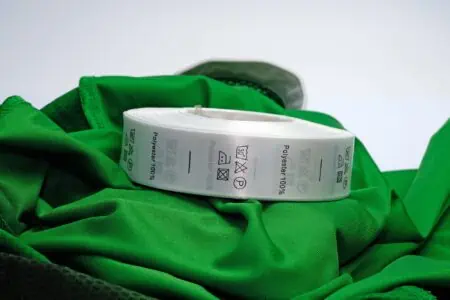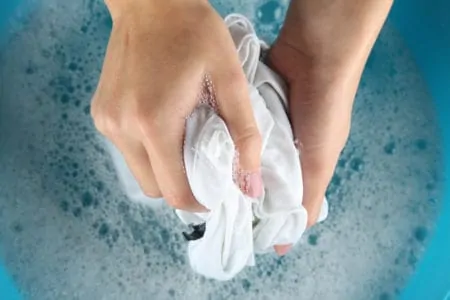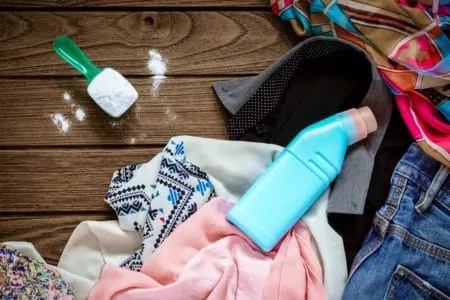Polyester is a durable fabric that can resist many water stains, but some stains, especially oil-based ones, can be tricky to remove.
If you’re wondering how to remove stains from polyester, you’ve come to the right place. With our expert advice, years of experience, and mounds of research, we have the best methods for removing stains.
This includes oil-based stains, ink, blood, food stains, and more. Don’t let any mess, spill, or accident ruin your favorite polyester piece.
Key Takeaways
- Remove food stains from polyester with a 1:1:1 solution of white vinegar, water, and dish soap, then wash in cold water.
- To remove ink stains, use rubbing alcohol to dab the stain, rinse with cold water, and wash the garment as usual.
- Treat blood stains with cold water, hydrogen peroxide, and ammonia, then wash on a cold cycle.
- Use baking soda and dish soap to remove oil-based stains from polyester, and wash at the warmest setting the garment can handle.
Best Stain Remover For Polyester
When removing stains from polyester shirts, dresses, and more, it’s important to stick to verified products. You don’t want to cause any damage. Here are the stain removers we recommend:
- Rubbing alcohol.
- Dish soap.
- Distilled white vinegar.
- Cold or warm water.
- Ammonia.
- Commercial stain removers that are safe for synthetic fabrics.
- Three percent hydrogen peroxide.
- Baking soda.
- Laundry detergent that is safe for synthetic fabrics.
- Borax.
- Oxygen bleach.
How to Remove Stains From Polyester
This polyester stain removal guide will walk you through common stubborn stains and how to spot-clean them. Don’t let any stain bring you down.
Ink or Crayon Stains
Creatives are meant to make a mess — but when you get a stain on your clothing, it can be distracting. Here’s how to effectively remove the crayon and ink stains so you can get back to your work of art:
- Prepare: Put a towel under the stained area so that the ink won’t bleed through. For instance, if the ink is on the front of your shirt, place a towel inside of the shirt.
- Blot: Use a white cloth or paper towel (to avoid color transfer) to blot the stain. Remove as much as possible.
- Rubbing alcohol: Pour a little rubbing alcohol onto a cotton pad or cloth. Dab the stain for a few minutes. This alone should help to lift the stain and dissolve the ink.
- Rinse: Rinse the garment in cold water.
- Soak: If the stain is still there, mix warm water with one tablespoon of dish soap and one tablespoon of distilled white vinegar. Soak the garment in the mixture for one hour.
- Rinse: Rinse the garment again. Repeat if necessary.
- Wash: Wash and dry the garment as usual.
Blood Stains
Blood stains are pesky, stubborn, and annoying. The key to removing blood on clothing is to act as quickly as possible. But if you have an old lingering stain, we can help.
- Flush with cold water: Rinse the garment thoroughly in cold water. This alone can help to remove a fresh blood stain. Add a little bit of dish soap to the garment and agitate it into the fibers to help with stain removal.
- Soak: If the stain persists, soak it in cold water for three hours. For more stubborn stains, you can add an enzyme-based stain remover, such as Rocco & Roxie Stain and Odor Eliminator.
- Treat the stain: Pour three percent hydrogen peroxide onto a white cloth and dab at the stain for a few minutes to dissolve it from the fibers.
- Soak: If necessary, you can soak the garment again. Soak it in a large sink with water. Add one teaspoon of laundry detergent and one teaspoon of ammonia. If you don’t have ammonia, use ½ cup of hydrogen peroxide. Soak overnight.
- Launder: Wash the garment in the washing machine on a cold cycle.
- Dry: Only dry the garment once the stain has been completely removed.
Oil-Based Stains
Oil and grease stains can be pretty challenging to remove from polyester. The fabric loves to absorb oil, making it tricky to pull from the fibers. But — we have a method worth trying:
- Prepare the area: Put a cloth or paper towel beneath the stain so that it doesn’t soak through to the rest of the garment. For instance, if the stain is on the front of a shirt, place a cloth inside the garment.
- Scrape excess: With the back of a spoon, scrape off as much excess grease as possible.
- Apply baking soda: Lay the garment flat and sprinkle a generous amount of baking soda over the stain. Let it sit for one to two hours before brushing it off into the trash can.
- Apply soap: Apply dish soap to the stain and let it sit for 10 minutes.
- Wash: Without removing the dish soap, toss the garment in the washing machine with a few other garments. Wash it at the warmest setting the garment can handle (check the care label). Add your regular laundry detergent, plus one cup of Borax or hydrogen peroxide — the choice is yours.
- Dry: Air dry the item to be sure the stain is gone. If not, repeat the process.
Food Stains
Food stains are the most common, especially for children’s clothes. When you spill food down your clothes at dinner, you can easily remove the stains with these steps:
- Scrape excess: Before getting started, it’s crucial to remove excess food from the clothing. This prevents you from embedding the food further into the fibers.
- Prepare cleaner: In a spray bottle, combine a 1:1:1 solution of white vinegar, water, and dish soap. Shake well.
- Apply: Apply the cleaner to the stain and let it sit for five minutes.
- Wash: Wash the garment in cold water and laundry detergent.
- Soak: If the stain remains, fill a sink with lukewarm water, ½ cup of white vinegar, and ¼ cup of dish soap. Mix well and add your garment. Let it soak for 30 minutes.
- Wash: Wash the garment in cold water with laundry detergent.
Yellow Stains
Do you hate pesky deodorant and sweat stains as much as we do? They appear so fast and can be stubborn to remove. Thankfully, we have a method to get these stains out of polyester, so they never bother you again.
- Pre-treat the stain: There are several ways to pre-treat yellow stains. One option is to soak the garment in oxygen bleach according to the packaging instructions. The second is to make a paste using equal parts baking soda and vinegar (or hydrogen peroxide). Apply it to the stain for one hour before washing.
- Wash: Wash the garment in cool or warm water with detergent and ½ cup of vinegar added to the rinse cycle.
- Dry: After washing, air dry the item and check the stain is gone. If not, repeat the process.
Makeup Stains
Our final method for how to get stains out of polyester involves cleaning makeup stains. Foundation, lipstick, concealer, and mascara can be hard to combat — but this method makes it easy.
- Apply dish soap: Apply dish soap to the stained area.
- Rub: Using a toothbrush, scrub gently at the stain to work the soap into the fibers. If necessary, add a splash of water to help the soap lather better. Continue for a few minutes until you notice the stain has lifted off.
- Wash as normal: Wash the garments in cold water with laundry detergent to remove the remaining stain.
- Dry: Air dry the garments and check that the stains are gone. If not, repeat the process.
Try This
The American Cleaning Institute recommends rubbing alcohol for removing lipstick stains (1). If you have some in the cupboard, swap the dish soap out for that.
Tips For Removing Stubborn Stains From Polyester
You know how to remove most stains from your polyester garment, but we have some extra tips for you. These hacks will help you tackle stubborn stains, protect your garments and achieve the best results.
- Act fast: The quicker you deal with a stain, the easier and more effectively it will remove.
- Read the care label: The fabric’s care label will tell you whether it’s safe to use bleach, heat, or warm air. When washing polyester in the machine, you never want to exceed the maximum recommended heat, so this is important.
- Avoid heat: Before the stain has been removed, avoid heat. Heat can set stains. While warm water can break up stains, always start with cold water when removing stains from polyester. Never tumble-dry garments until the stain is 100% gone.
- Dry clean-only fabrics: If your polyester garment is marked as dry-clean only (which is rare), blot as much of the stain away. Then take it to a professional to avoid damage.
- For tough stains: For tough stains, we recommend washing in cold water with a heavy-duty laundry detergent. Tide Hygienic Clean Heavy 10X Duty is a powerful option. Use the heavily-soiled dosage amount; if your machine has an option for heavily-soiled items, use that, too.
- Don’t use bleach: Most polyester garments aren’t compatible with bleach. Always check the care label. Typically, bleach will damage the polyester, so avoid using it.
What to Avoid When Cleaning Polyester
Polyester is a popular material for clothing, but you must wash it carefully. Here is what you should avoid when cleaning it:
- Chlorine bleach: As mentioned, bleach is not safe for polyester. Bleach will discolor polyester and can remove the outer coating of color in the item (2). Please note that oxygen bleach is perfectly safe.
- Too much heat: Avoid high heat from the washing machine, tumble dryer, and iron. Warm or cold is best — check the care label for specific temperature guidance.
- Harsh chemicals: We recommend choosing a laundry detergent free from harsh chemicals. Using a mild or natural detergent can help your polyester item last longer.
- Cleaning alongside heavy garments: Don’t wash light polyester garments in the same washing cycle as heavy cotton or denim garments. The weight, zippers, and buttons can snag and tear the polyester.
- Fabric softener: Avoid fabric softener for polyester. Polyester has useful wicking abilities, and fabric softener can leave behind a waxy coating, preventing this function. In fact, we don’t recommend using fabric softener on synthetic fabrics, like spandex or nylon.
FAQs
Pretty Polyester
With these tips on how to remove stains from polyester, your clothing is now spic and span.
Whether you were suffering stains from ink, sweat, or oil — we have tons of tips to help you out. It’s fairly easy to remove marks from polyester, especially when using the correct methods and products.
Don’t forget to avoid high heat, bleach, and harsh chemicals. This can damage your polyester garment for good.










